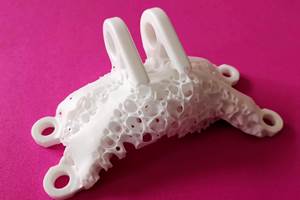Avio Utilizes Velo3D Metal Printers for Developing Propulsion Systems
The Italian space propulsion innovator is installing the printers in its Colleferro, Italy, headquarters to produce mission-critical parts for its family of rocket engines.
Share
Read Next
Velo3D CEO Benny Buller (fourth from left) and members of the Avio and Velo3D teams at the Paris Air Show. Photo Credit: Velo3D
Italian aerospace company Avio has purchased a Velo3D Sapphire XC 1MZ metal printer and an original Sapphire printer to support the development and production of its propulsion systems to accelerate the advancement of the space industry. Velo3D’s solution was selected for its ability to produce quality parts with optimized geometries for the highest performance, and the large build volume of the Sapphire XC 1MZ. Both printers are calibrated to produce parts in nickel-based alloy which delivers strength and corrosion resistance at extreme temperatures.
Avio works on making space more accessible and affordable. With a strong focus on propulsion systems, Avio has delivered competitive solutions for launching institutional, governmental and commercial payloads into orbit through its Vega family of launch vehicles. By adopting Velo3D's fully integrated solution, Avio aims to achieve new milestones in design quality and time-to-market for its products.
With one of the largest build volumes for laser powder bed fusion 3D printers, the Sapphire XC 1MZ 3D printer has a print volume that is 600 mm in diameter and 1,000 mm in height. The original Sapphire has a print volume of 315 mm in diameter and 400 mm in height. Both printers enable Avio to overcome the constraints of traditional manufacturing methods, including conventional additive manufacturing solutions. The printers accomplish this by providing a wide breadth of geometric design freedom and a high degree of precision.
The printing solution from Velo3D empowers Avio to optimize its designs and manufacture quality, high-performance components with intricate geometries that were previously unattainable. The result is improved performance, reduced weight, enhanced reliability and, ultimately, a more efficient and accessible space industry.
“Avio is one of the leading space companies in Europe and we are thrilled to partner with them in their pursuit of groundbreaking propulsion systems,” says Benny Buller, founder and CEO of Velo3D. “They work with some of the most innovative companies and agencies in Europe and around the world to provide them with the technology they need to reach space. The Sapphire XC 1MZ will help Avio further accelerate the development of its propulsion systems and contribute to the ongoing transformation of the space industry.”
The cooperation between Avio and Velo3D comes at a pivotal moment in the growing space industry, which is witnessing transformative advancements. With the advent of 3D printing, the industry has gained momentum by enabling faster time-to-market, distributed supply chains, part consolidation and enhanced performance capabilities. Velo3D is one of the leading 3D printing providers enabling new space companies, with customers that include SpaceX, Launcher and other innovators.
- Learn about Velo3D’s Flow 5.0 Software which is said to enhance control over the 3D printing process. The software’s new features include user-selectable core parameters, preprint analysis to identify potential costly and time-consuming errors, and rapid resequencing for multipart prints.
- Read about Velo3D’s partnership with PhysicsX to provide engineers with AI simulation tooling. The collaboration gives Velo3D customers access to AI-enabled physics simulation and optimization capabilities, and gives PhysicsX customers increased manufacturing flexibility to produce their most advanced concepts.
Related Content
3D Printed Brake Panel for the Rail Industry: The Cool Parts Show #52
In this episode of The Cool Parts Show, laser powder bed fusion simplifies the manufacturing of air brake panels for light rail systems made by Wabtec.
Read MoreXJet Produces First Entirely Ceramic Piston for Chaos Ultracar
Company says no other technology could achieve the accuracy and complexity required to create Spyros Panopoulos Automotive’s lightweight ceramic design.
Read MoreSpherene Creates Metamaterial with Geometry Derived from Spheres
An algorithm developed by Spherene Inc. generates Adaptive Density Minimal Surfaces (ADMS) as a self-supporting infill strategy that can be used to reduce mass and manage material properties in 3D printed parts.
Read More8 Cool Parts From Formnext 2023: The Cool Parts Show #65
New additive manufacturing technologies on display at Formnext were in many cases producing notable end-use components. Here are some of the coolest parts we found at this year’s show.
Read MoreRead Next
Hybrid Additive Manufacturing Machine Tools Continue to Make Gains (Includes Video)
The hybrid machine tool is an idea that continues to advance. Two important developments of recent years expand the possibilities for this platform.
Read More4 Ways the Education and Training Challenge Is Different for Additive Manufacturing
The advance of additive manufacturing means we need more professionals educated in AM technology.
Read MoreAt General Atomics, Do Unmanned Aerial Systems Reveal the Future of Aircraft Manufacturing?
The maker of the Predator and SkyGuardian remote aircraft can implement additive manufacturing more rapidly and widely than the makers of other types of planes. The role of 3D printing in current and future UAS components hints at how far AM can go to save cost and time in aircraft production and design.
Read More






















